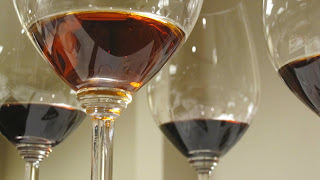Wine,
Port, Cheese & Chocolate Tasting Notes – Vail 2012
Chef Robert N. Corey, C.E.C.
The Taste of Vail April 5 - 8, 2012
'Got E = mc2 ?' (one of these two figures has a high IQ...the other one wears a red cap!)
The Cliff Notes version of the tastings...: Food
changes wine – wine rarely changes the food.
The moral of the story is to pair food to taste (your taste) and to the wine style, not necessarily the varietal.
The following are my notes compiled from lectures and tastings at The Taste of Vail in Vail, Colorado – April 5-8, 2012. Remember that personal subjectivity is crucial when pairing food with wine. Wine is certainly the most difficult of the alcohols to pair with food. Acidity, oak, leather, green bean, vanillan, malic acid, etc... When pairing food and beer simply mirror the flavor and taste profiles, and the same with spirits and food. With wine one must recognize the style of the wine, the taste and flavors of the food and work from there… Pairing food and wine can be the hardest as acid and bitterness are prevalent. Sour food is very wine friendly. So, that's easy! Select and adapt accordingly.
The following are my notes compiled from lectures and tastings at The Taste of Vail in Vail, Colorado – April 5-8, 2012. Remember that personal subjectivity is crucial when pairing food with wine. Wine is certainly the most difficult of the alcohols to pair with food. Acidity, oak, leather, green bean, vanillan, malic acid, etc... When pairing food and beer simply mirror the flavor and taste profiles, and the same with spirits and food. With wine one must recognize the style of the wine, the taste and flavors of the food and work from there… Pairing food and wine can be the hardest as acid and bitterness are prevalent. Sour food is very wine friendly. So, that's easy! Select and adapt accordingly.
1.
Classifying
Wine: Taste. Profile. Style.
A. Fruity
& sweet (includes dessert wines).
B: Dry white wines, w/o oak or very little oak
influence (includes most sparkling wines).
C: Dry white wines with oak and/or light, fruity
red wines.
D: Strong red wines with tannins.
Within
each of these categories, there are several levels, corresponding to the
intensity of the characteristics, such as oak, tannin, sweetness, etc.
2.
Classifying
Food
Any
specific dish, or cheese, will contain one or more of the five basic
tastes: sweet, sour, salty, bitter and protein/umami. These dominant tastes in the food will have a
profound effect on the taste of the wine.
A. Sweet
& protein/umami dominated foods reduce wine aromas and make wine textures
(acidity, bitterness, astringency, and tannins) stronger.
B. Sour
and salt dominated foods make wine textures milder (richer, smoother, sweeter)
and can accentuate aromas.
C. When
the tastes in the food are balanced, with no one taste dominating another, the
wine will remain relatively unchanged, just as the winemaker intended. This is the standard objective in food and
wine pairing.
3.
Cheese
Cheese
is commonly classified by its style or firmness, type of milk, country of
origin and by its age. When pairing
cheese with wine the most important thing to think about is its taste profile. Every cheese contains varying levels of
sweetness, protein/umami, acidity and salt.
By evaluating the sweetness/umami versus salt/acidity in the cheese and
grouping them into categories based on taste profile, you can pair the
appropriate wine to any cheese.
A.
Fresh, Creamy Cheeses; Protein/Umami and
Sweet Dominant (lack of salt & acidity)
Examples:
fresh Mozzarella, Ricotta, young Brie, Camembert.
Reaction:
The protein and sweetness will make wine taste stronger and accentuate
bitterness and tannins.
Solution: Lighter-style
wines with soft tannins and crisp, fresh flavors.
Suggested Wines: Low-Oak
wines such as Chenin-Blanc, Gerwurtztraminer, Viognier, Sauvignon and
Chardonnay to light reds such as White Zinfandel, Beaujolais, Pinot Noir and lighter-style
Merlots.
B.
Young, Tangy Cheeses; Acidity & Protein/Umami Dominant (no distinct
acidic bite). Examples: Chevre/fresh
Goat Cheese, Crescenza, Tomini.
Reaction: These
cheeses soften high acid and low-astringency wines but will strengthen full
tannin, high stringency wines.
Solution:
Crisp to high acidity wines, with low to moderate oak, and low tannins.
Suggested Wines:
Sauvignon Blanc, Pinot Grigio, Dry Reisling, Chablis-Style Chardonnay, Pinot
Noir, lighter Chianti, Zinfandel and Shiraz.
C.
Young, tangy and salty Cheeses; Acidity & Protein/Umami Balanced
(most universal category of cheeses – will taste good with the widest variety
of wines).
Examples:
Young Cheddar, Gruyere, Cambozola, Blue Castello, triple-crème Pierre Robert,
aged goat Crottin, low-salt Feta.
Reaction:
The balance of flavors will have a virtually neutral effect on the wines or
may soften the astringency/tannins in wine and accentuate fruit flavors.
Solution:
Because of the universal quality of the cheese, play with your favorite
wines.
Suggested
Wines: Riesling, Chardonnay, Sauvignon Blanc, Merlot, Shiraz, Zinfandel,
Cabernet Sauvignon.
D.
Aged, Salty Cheeses; Salt &
Protein/Umami Dominant (highest amount of salt and concentrated flavor).
Examples:
Roquefort, Stilton, Parmesan, Asiago, aged Sharp Cheddar, Feta.
Reaction:
Salt dominance has an initial reaction of softening the wines with a
secondary strengthening of astringency
and tannins from the high protein.
Solution:
Theses cheeses need softy, sweet wines or dessert wines, or strong, rich,
but soft tannin wines.
Suggested
Wines: Theses cheeses traditionally served with sweet and
fortified wines such as Port, (with Stilton) or Sauternes (with Roquefort)
since the cheese make the wines milder and richer. Try Late-harvest wines, Vin Santo, Ice Wine,
sweet Sherry, Madeira, Amarone, Zinfandel, or Shiraz.
In
general serve soft cheeses with soft wines and hard cheeses with hard
wine. Either way, enjoy.
Peace. ~R
Peace. ~R






No comments:
Post a Comment